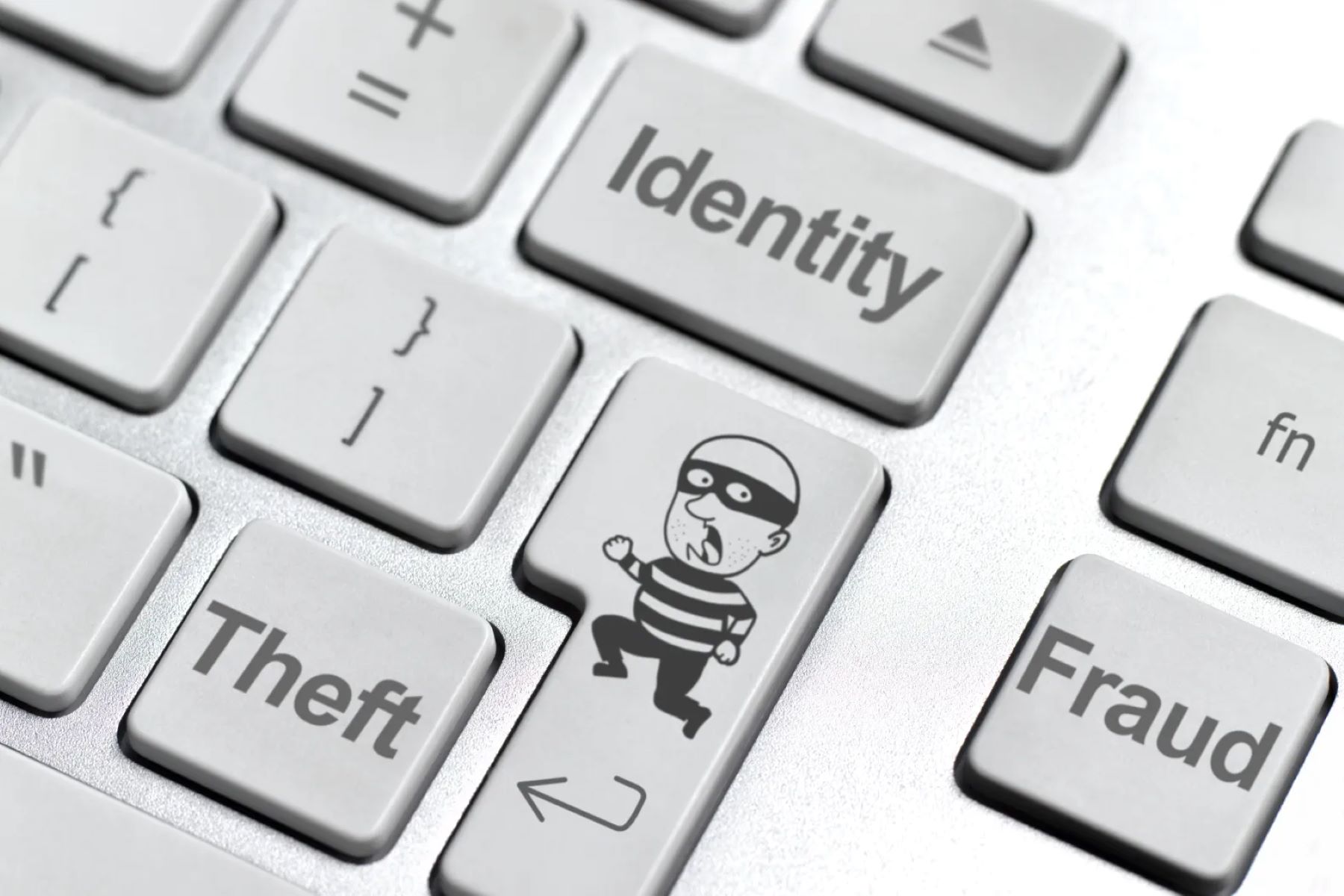Home>Technology and Computers>10 Genius Ways To Respond To Identity Theft


Technology and Computers
10 Genius Ways To Respond To Identity Theft
Published: February 17, 2024
Discover 10 genius ways to respond to identity theft in the digital age. Protect your identity with the latest technology and computer solutions.
(Many of the links in this article redirect to a specific reviewed product. Your purchase of these products through affiliate links helps to generate commission for Regretless.com, at no extra cost. Learn more)
Table of Contents
Introduction
Identity theft is a growing concern in today's digital age, posing a significant threat to individuals' financial security and personal well-being. This pervasive crime occurs when someone wrongfully obtains and uses another person's personal data for fraudulent purposes, such as making unauthorized purchases, opening credit accounts, or filing bogus tax returns. The impact of identity theft can be devastating, resulting in financial loss, damaged credit, and emotional distress.
As technology continues to advance, identity thieves are finding increasingly sophisticated ways to access and misuse personal information. From phishing scams and data breaches to social engineering tactics, the methods employed by these criminals are diverse and constantly evolving. Consequently, it is crucial for individuals to remain vigilant and take proactive measures to safeguard their identities.
In this article, we will explore ten genius ways to respond to identity theft, empowering you with the knowledge and strategies to protect yourself from this pervasive threat. By implementing these proactive measures, you can fortify your defenses against identity theft and minimize the risk of falling victim to malicious activities. From monitoring your accounts regularly to leveraging advanced security measures, each strategy is designed to bolster your personal security and mitigate the potential impact of identity theft.
As we delve into these ingenious tactics, it's important to recognize that safeguarding your identity is an ongoing endeavor that demands constant vigilance and adaptability. By staying informed and proactive, you can effectively combat the risks posed by identity theft and preserve your financial well-being and peace of mind. Let's embark on this journey to fortify your defenses and thwart the nefarious efforts of identity thieves.
Monitor Your Accounts Regularly
Monitoring your financial accounts and credit reports regularly is a fundamental aspect of protecting yourself against identity theft. By staying vigilant and actively reviewing your accounts, you can swiftly detect any unauthorized or suspicious activity, allowing you to take immediate action to mitigate potential damages.
Why Regular Monitoring is Crucial
Regular monitoring serves as an early warning system, enabling you to identify any irregularities or unauthorized transactions that may indicate fraudulent activity. Whether it's your bank accounts, credit cards, or investment portfolios, keeping a close eye on your financial records is essential for detecting any signs of unauthorized access or fraudulent charges.
How to Monitor Effectively
Utilize online banking and mobile apps to monitor your accounts daily, checking for any unfamiliar transactions or discrepancies. Many financial institutions offer real-time alerts and notifications for account activities, empowering you to stay informed about any changes or suspicious behavior.
Additionally, regularly reviewing your credit reports from major credit bureaus such as Equifax, Experian, and TransUnion can provide valuable insights into your credit history and alert you to any unauthorized inquiries or accounts opened in your name. Under the Fair Credit Reporting Act, you are entitled to one free credit report from each bureau annually, allowing you to conduct comprehensive reviews of your credit history.
Implementing Proactive Measures
In addition to monitoring your accounts, consider leveraging identity theft protection services that offer advanced monitoring and alert features. These services can provide real-time notifications of potential identity theft risks, such as unauthorized use of your Social Security number or changes to your credit files, enabling you to take swift action to address any potential threats.
By proactively monitoring your accounts and credit reports, you can effectively safeguard your financial well-being and personal information from the pervasive threat of identity theft. This proactive approach empowers you to detect and respond to suspicious activities in a timely manner, minimizing the potential impact of fraudulent behavior on your financial stability and peace of mind.
Freeze Your Credit
Freezing your credit is a powerful proactive measure that can significantly bolster your defenses against identity theft. This strategic approach involves placing a freeze on your credit reports with the major credit bureaus, effectively restricting access to your credit information. By implementing a credit freeze, you can thwart potential identity thieves from opening new accounts or obtaining credit in your name, providing a robust safeguard against unauthorized financial activities.
The Impact of Credit Freezes
When you initiate a credit freeze, the credit bureaus are required to restrict access to your credit reports, making it challenging for unauthorized individuals to open new credit accounts using your personal information. This proactive step can serve as a formidable deterrent against identity theft, as potential creditors and lenders will be unable to access your credit history without your authorization, effectively thwarting fraudulent attempts to exploit your financial identity.
How to Freeze Your Credit
Initiating a credit freeze is a straightforward process that involves contacting each of the major credit bureaus – Equifax, Experian, and TransUnion – to request the freeze. This can typically be done online, by phone, or through mail, and may require providing personal information to verify your identity. Once the credit freeze is in place, the bureaus will restrict access to your credit reports, adding an extra layer of security to your financial profile.
Managing a Credit Freeze
While a credit freeze offers robust protection against identity theft, it's important to note that it can also impact your ability to apply for new credit or loans. If you intend to open new accounts or apply for credit in the future, you will need to temporarily lift the freeze to allow access to your credit reports. This can be done by contacting the credit bureaus and providing the necessary authorization to lift the freeze for a specified period, after which it will be reinstated automatically.
Read more: 10 Amazing Ways To Express Gratitude
Leveraging Security and Peace of Mind
By proactively freezing your credit, you can fortify your defenses against identity theft and unauthorized financial activities. This proactive measure serves as a potent deterrent, making it significantly more challenging for fraudsters to exploit your credit information for illicit purposes. Additionally, many states provide consumers with the ability to freeze their credit reports free of charge, offering a cost-effective and powerful tool for enhancing personal security and peace of mind.
Implementing a credit freeze empowers individuals to take control of their financial information and mitigate the risks posed by identity theft. This proactive step can serve as a cornerstone of a comprehensive strategy to safeguard personal and financial well-being, providing a formidable barrier against unauthorized access to credit information and bolstering overall resilience against the pervasive threat of identity theft.
Use Two-Factor Authentication
In today's digital landscape, where cyber threats loom large, implementing robust security measures is paramount in safeguarding sensitive online accounts. Two-factor authentication (2FA) stands out as a highly effective method for enhancing the security of various online platforms and services. This multifaceted approach adds an extra layer of protection beyond traditional password-based security, significantly reducing the risk of unauthorized access and potential identity theft.
The Power of Two-Factor Authentication
Two-factor authentication reinforces the login process by requiring users to provide two forms of identification before accessing their accounts. Typically, this involves something the user knows, such as a password, combined with something they possess, like a unique code sent to their mobile device or generated by an authentication app. By necessitating these dual authentication factors, 2FA substantially bolsters the security posture of online accounts, mitigating the vulnerabilities associated with password-only protection.
Implementing Two-Factor Authentication
Many online platforms and services offer the option to enable two-factor authentication as part of their security settings. Once activated, users are prompted to provide the additional authentication factor, often delivered via SMS, email, or authenticator apps, when logging into their accounts. This added layer of security serves as a potent deterrent against unauthorized access, as even if a malicious actor obtains the user's password, they would still require the secondary authentication factor to gain entry.
Read more: 10 Powerful Ways To Lead By Example
Advantages of Two-Factor Authentication
The adoption of two-factor authentication confers several compelling advantages in the realm of identity protection. Firstly, it significantly reduces the likelihood of unauthorized access, as cybercriminals would face formidable barriers beyond the initial password hurdle. Moreover, 2FA enhances overall account security, instilling greater confidence in the integrity of online transactions and communications. By leveraging this advanced security measure, individuals can bolster their defenses against identity theft and fortify the protection of their sensitive personal information.
Embracing Enhanced Security
Incorporating two-factor authentication into your online accounts is a proactive step toward fortifying your digital security. By embracing this multifaceted approach, you can substantially reduce the susceptibility of your accounts to unauthorized access and potential identity theft. As cyber threats continue to evolve, leveraging advanced security measures like 2FA is instrumental in safeguarding your digital identity and preserving your online privacy and security.
Implementing two-factor authentication empowers individuals to take proactive control of their digital security, reinforcing their defenses against identity theft and unauthorized access. By embracing this robust security measure, individuals can navigate the digital landscape with greater confidence, knowing that their online accounts are fortified with an additional layer of protection.
Secure Your Devices
Securing your devices is a critical aspect of safeguarding your digital identity and personal information from the pervasive threat of identity theft. In today's interconnected world, where smartphones, tablets, and computers serve as gateways to a myriad of online activities, ensuring the robust security of these devices is paramount in fortifying your defenses against cyber threats and unauthorized access.
Importance of Device Security
The security of your devices directly impacts the integrity of your digital interactions and the protection of your sensitive personal information. From banking transactions and email communications to social media interactions and online shopping, a vast array of sensitive data flows through your devices on a daily basis. As such, implementing stringent security measures is essential in mitigating the risks associated with potential breaches and unauthorized access.
Implementing Device Security Measures
1. Strong Passwords and Biometric Authentication
Utilize strong, unique passwords for each of your devices, and where available, leverage biometric authentication methods such as fingerprint or facial recognition to enhance access control. These measures bolster the security of your devices, making it significantly more challenging for unauthorized individuals to gain access.
2. Regular Software Updates
Frequently update the operating systems and applications on your devices to patch security vulnerabilities and ensure the latest security features are in place. Outdated software can expose your devices to exploitation by cybercriminals, underscoring the importance of proactive software maintenance.
3. Encryption
Enable device encryption to safeguard the data stored on your devices, rendering it indecipherable to unauthorized parties. Encryption adds a powerful layer of protection, particularly in the event of device theft or loss, mitigating the risk of unauthorized access to your sensitive information.
4. Secure Wi-Fi Connections
Exercise caution when connecting to public Wi-Fi networks, as these can be prime targets for cyber attacks. Whenever possible, utilize virtual private network (VPN) services to encrypt your internet traffic and enhance the security of your online activities.
Advantages of Device Security
By fortifying the security of your devices, you can significantly reduce the susceptibility of your digital interactions to unauthorized access and potential identity theft. These proactive measures not only safeguard your personal information but also contribute to a more secure and resilient digital ecosystem, where the integrity of online communications and transactions is upheld.
Embracing Enhanced Device Security
Incorporating robust security measures into your devices is a proactive step toward fortifying your digital security and preserving the confidentiality of your personal information. By embracing these advanced security practices, individuals can navigate the digital landscape with greater confidence, knowing that their devices are fortified against unauthorized access and potential exploitation.
Implementing comprehensive device security measures empowers individuals to take proactive control of their digital security, reinforcing their defenses against identity theft and unauthorized access. By embracing these robust security practices, individuals can navigate the digital landscape with greater confidence, knowing that their devices are fortified against unauthorized access and potential exploitation.
Shred Important Documents
Shredding important documents is a crucial step in safeguarding sensitive personal information and mitigating the risk of identity theft. In an era where paper trails abound, from financial statements and credit card bills to medical records and legal documents, the disposal of these materials presents a potential vulnerability that can be exploited by identity thieves. By adopting a proactive approach to document disposal, individuals can fortify their defenses against unauthorized access to their personal information and preserve the integrity of their sensitive data.
Importance of Document Shredding
The significance of document shredding lies in its capacity to render sensitive information irretrievable, thereby thwarting the efforts of identity thieves seeking to exploit discarded documents. Personal and financial records often contain a wealth of confidential data, including Social Security numbers, account details, and personally identifiable information, making them prime targets for malicious actors. By shredding these documents, individuals can effectively neutralize the risk of unauthorized access and protect their privacy and financial well-being.
Implementing Document Shredding Practices
-
Identify Sensitive Documents: Begin by identifying the types of documents that contain sensitive information, such as bank statements, tax returns, medical records, and credit card statements.
-
Invest in a Cross-Cut Shredder: Acquire a high-quality cross-cut shredder, which effectively transforms documents into confetti-like particles, rendering them virtually impossible to reassemble.
-
Establish a Shredding Routine: Develop a regular shredding routine to promptly dispose of documents containing sensitive information. This proactive practice ensures that sensitive materials are promptly rendered unreadable and safeguarded from potential exploitation.
-
Secure Disposal of Shredded Material: After shredding documents, ensure the secure disposal of the shredded material to prevent any possibility of reconstruction. Consider utilizing secure disposal methods, such as mixing shredded materials with non-sensitive waste or utilizing professional document destruction services.
Advantages of Document Shredding
The practice of shredding important documents offers multifaceted advantages, including:
-
Protection Against Identity Theft: By shredding sensitive documents, individuals can significantly reduce the risk of identity theft, safeguarding their personal and financial information from unauthorized access.
-
Preservation of Privacy: Document shredding reinforces the confidentiality of personal information, preserving privacy and minimizing the potential for exploitation by malicious entities.
-
Compliance with Data Protection Regulations: In many cases, document shredding is a key component of compliance with data protection regulations, ensuring that sensitive information is handled and disposed of in a secure and responsible manner.
Embracing Document Security
By embracing document shredding as a fundamental aspect of personal security, individuals can fortify their defenses against identity theft and unauthorized access to sensitive information. This proactive approach not only mitigates the risks associated with discarded documents but also contributes to a more secure and resilient personal data ecosystem, where the integrity of sensitive information is upheld.
Implementing comprehensive document shredding practices empowers individuals to take proactive control of their personal security, reinforcing their defenses against identity theft and unauthorized access. By embracing these robust security measures, individuals can navigate the complexities of document disposal with confidence, knowing that their sensitive information is safeguarded from potential exploitation.
Be Cautious with Personal Information
In an era defined by digital connectivity and ubiquitous online interactions, exercising caution with personal information is paramount in safeguarding oneself against the perils of identity theft. The proliferation of online platforms, social media networks, and e-commerce ecosystems has created an environment where sensitive personal data is constantly exchanged and utilized, presenting an array of potential vulnerabilities that can be exploited by malicious actors.
The prudent management of personal information begins with a heightened awareness of the data being shared and the platforms through which it is disseminated. Individuals must exercise discretion when divulging personal details, refraining from oversharing on public forums and social media platforms. Information such as full names, birthdates, addresses, and contact details can serve as valuable ammunition for identity thieves, enabling them to construct detailed profiles for fraudulent activities.
Moreover, individuals should exercise caution when responding to unsolicited requests for personal information, whether through phone calls, emails, or online forms. Scammers often employ sophisticated tactics to elicit sensitive data under false pretenses, posing as legitimate entities to deceive unsuspecting individuals. Verifying the authenticity of requests and adopting a skeptical approach to unsolicited communications are essential in mitigating the risk of falling victim to phishing scams and social engineering ploys.
Furthermore, the management of personal information extends to the realm of physical documents and records. Individuals should securely store and dispose of sensitive documents, such as financial statements, tax records, and identification documents, to prevent unauthorized access and potential exploitation. Implementing secure document storage practices and utilizing shredding services for the disposal of sensitive materials can significantly reduce the risk of identity theft through physical means.
In the digital domain, the proliferation of online transactions and data-sharing activities necessitates a discerning approach to safeguarding personal information. Utilizing secure, encrypted connections for online activities, exercising caution when sharing sensitive data, and leveraging reputable, secure platforms for financial transactions are essential in fortifying the security of personal information.
By embracing a cautious and discerning approach to personal information, individuals can fortify their defenses against identity theft and unauthorized access to sensitive data. This proactive stance not only mitigates the risks associated with data exposure but also contributes to a more secure and resilient personal data ecosystem, where the integrity of sensitive information is upheld.
Report Suspicious Activity Immediately
Reporting suspicious activity immediately is a pivotal step in mitigating the potential impact of identity theft and safeguarding personal and financial well-being. Promptly identifying and addressing any signs of unauthorized access or fraudulent behavior is essential in minimizing the repercussions of malicious activities and preventing further exploitation of sensitive information.
When encountering unusual or suspicious activity, such as unauthorized transactions, unfamiliar account access, or unexplained changes to personal information, individuals should take swift and decisive action. This involves contacting the relevant financial institutions, service providers, or authorities to report the suspicious behavior and initiate the necessary steps to address and rectify the situation.
The process of reporting suspicious activity typically involves notifying the affected financial institutions, credit card companies, or online service providers of the unauthorized behavior. This may entail placing holds on affected accounts, disputing fraudulent charges, and updating security measures to prevent further unauthorized access. Additionally, individuals should consider filing reports with law enforcement agencies and relevant regulatory bodies to document the incident and aid in the investigation of potential identity theft.
Timely reporting of suspicious activity not only serves to protect the individual's financial assets and personal information but also contributes to the collective efforts in combating identity theft and fraudulent behavior. By promptly notifying the relevant authorities and entities, individuals can play a proactive role in identifying and addressing potential security breaches, contributing to the preservation of a secure and trustworthy digital environment.
Moreover, reporting suspicious activity serves as a crucial mechanism for documenting and addressing potential vulnerabilities in personal security practices. By analyzing and responding to suspicious incidents, individuals can gain valuable insights into potential weaknesses in their security posture, enabling them to fortify their defenses and minimize the likelihood of future unauthorized access or exploitation.
In essence, the immediate reporting of suspicious activity is a fundamental component of a proactive and resilient approach to safeguarding personal and financial security. By promptly identifying and addressing potential threats, individuals can mitigate the impact of identity theft and contribute to the ongoing efforts in promoting a secure and trustworthy digital ecosystem.
Update Your Passwords Regularly
Regularly updating your passwords is a fundamental practice in fortifying your digital security and mitigating the risks associated with identity theft. Passwords serve as the primary line of defense against unauthorized access to your online accounts, and ensuring their strength and freshness is essential in upholding the integrity of your digital identity.
Importance of Password Updates
The importance of updating passwords lies in the dynamic nature of cyber threats and the evolving tactics employed by malicious actors. As cybercriminals continually refine their methods to exploit vulnerabilities, maintaining up-to-date and robust passwords is critical in thwarting unauthorized access to your sensitive information. By regularly changing your passwords, you disrupt potential intrusion attempts and reduce the likelihood of exploitation through compromised credentials.
Best Practices for Password Updates
When updating your passwords, adhere to best practices to maximize their effectiveness:
-
Complexity and Uniqueness: Create strong, unique passwords for each of your accounts, incorporating a combination of uppercase and lowercase letters, numbers, and special characters. Avoid using easily guessable information, such as birthdays or common phrases, and refrain from reusing passwords across multiple accounts.
-
Frequency: Establish a routine for updating your passwords at regular intervals, such as every 60 to 90 days. This periodic refreshment of credentials enhances the resilience of your accounts and minimizes the window of opportunity for potential exploitation.
-
Multi-Factor Authentication: Where available, complement password updates with the implementation of multi-factor authentication (MFA). This additional layer of security fortifies your accounts, requiring multiple forms of verification for access, thereby reducing the impact of compromised passwords.
-
Password Management Tools: Consider utilizing reputable password management tools to securely store and manage your credentials. These tools offer the convenience of generating and storing complex passwords while simplifying the process of updating and rotating credentials across various accounts.
Advantages of Regular Password Updates
Regularly updating your passwords confers several advantages, including:
- Enhanced Security: By refreshing your passwords, you bolster the security of your accounts, reducing the susceptibility to unauthorized access and potential identity theft.
- Proactive Defense: Password updates serve as a proactive defense mechanism, disrupting potential intrusion attempts and fortifying the resilience of your digital identity.
- Risk Mitigation: The periodic rotation of passwords mitigates the risks associated with compromised credentials, minimizing the potential impact of unauthorized access and exploitation.
Embracing Password Security
By embracing the practice of regularly updating your passwords, you empower yourself to proactively safeguard your digital identity and personal information. This proactive approach not only mitigates the risks associated with unauthorized access but also contributes to a more secure and resilient digital ecosystem, where the integrity of online accounts and interactions is upheld.
In essence, the regular updating of passwords is a cornerstone of a comprehensive strategy to fortify personal security and combat the pervasive threat of identity theft. By prioritizing the strength and freshness of your passwords, you bolster your defenses against unauthorized access and contribute to the ongoing efforts in promoting a secure and trustworthy digital environment.
Consider Identity Theft Protection Services
In an era characterized by pervasive digital connectivity and evolving cyber threats, the consideration of identity theft protection services emerges as a strategic avenue for fortifying personal security and mitigating the risks associated with unauthorized access and fraudulent activities. These specialized services are designed to provide comprehensive monitoring, detection, and resolution capabilities, empowering individuals to proactively safeguard their identities and financial well-being.
Identity theft protection services offer a multifaceted approach to personal security, encompassing advanced monitoring of credit files, public records, and black market activities to detect potential signs of identity theft. By leveraging sophisticated algorithms and data analytics, these services can swiftly identify irregularities and suspicious behavior, enabling individuals to take prompt action in response to potential threats.
Furthermore, many identity theft protection services provide real-time alerts and notifications, promptly notifying individuals of any detected anomalies or potential risks to their personal information. This proactive alert system empowers individuals to stay informed and vigilant, facilitating swift responses to emerging threats and potential security breaches.
In addition to monitoring and alert capabilities, identity theft protection services often offer resolution assistance in the event of identity theft incidents. This may include dedicated support from identity theft resolution specialists, who can guide individuals through the process of addressing and rectifying fraudulent activities, as well as providing assistance in navigating the complexities of identity theft recovery.
Moreover, some identity theft protection services extend their offerings to include insurance coverage for identity theft-related expenses and financial losses. This added layer of protection provides individuals with a safety net against the potential financial impact of identity theft, offering peace of mind and financial resilience in the face of malicious activities.
By considering identity theft protection services, individuals can proactively fortify their defenses against identity theft and unauthorized access to their personal information. These services offer a comprehensive suite of tools and resources to bolster personal security, providing a proactive stance against the pervasive threat of identity theft in today's digital landscape.
Conclusion
In conclusion, the threat of identity theft looms large in today's interconnected and digitized world, posing significant risks to individuals' financial security and personal well-being. As we navigate this landscape of evolving cyber threats and sophisticated malicious activities, it becomes increasingly crucial to fortify our defenses and adopt proactive measures to safeguard our identities.
The ten genius ways to respond to identity theft presented in this article collectively form a comprehensive strategy for mitigating the risks associated with unauthorized access and fraudulent activities. From the proactive monitoring of financial accounts and credit reports to the implementation of robust security measures such as two-factor authentication and device security, each strategy serves as a vital component in the ongoing battle against identity theft.
By emphasizing the importance of regular monitoring, proactive security measures, and cautious management of personal information, individuals can significantly reduce the susceptibility of their identities to exploitation and unauthorized access. Furthermore, the proactive adoption of identity theft protection services and the diligent management of sensitive documents contribute to a resilient security posture, empowering individuals to navigate the digital landscape with confidence and peace of mind.
It is essential to recognize that safeguarding our identities is an ongoing endeavor that demands vigilance, adaptability, and a proactive stance against potential threats. By embracing the insights and strategies presented in this article, individuals can fortify their defenses, mitigate the risks of identity theft, and contribute to the cultivation of a secure and trustworthy digital ecosystem.
As we conclude this exploration of ingenious ways to respond to identity theft, it is paramount to underscore the significance of proactive engagement and ongoing vigilance. By staying informed, adopting robust security practices, and leveraging advanced protective measures, individuals can navigate the digital realm with resilience and confidence, knowing that their identities are safeguarded against the pervasive threat of identity theft.
In this ongoing battle for personal security and digital resilience, the adoption of proactive measures and the continuous pursuit of knowledge serve as our most potent weapons. By embracing these principles and integrating them into our daily practices, we empower ourselves to navigate the digital landscape with confidence, resilience, and a steadfast commitment to safeguarding our identities.







